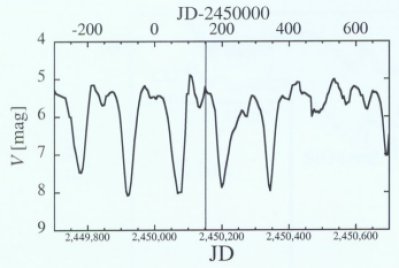 The light curve of R Scuti reveals a 71 day period between
alternating deep and shallow minima, the deep minima taking place
every 142 days. The behavior sometimes goes away, but inevitably
returns. The Julian Date is a running count of days since January
1, 4713 BC, of the Julian Calendar. JD 2450000 corresponds to
October 9, 1995.
Janet Mattei (American Association of Variable Star Observers),
from an article by M. Matsuura et al. in Astronomy and
Astrophysics
The light curve of R Scuti reveals a 71 day period between
alternating deep and shallow minima, the deep minima taking place
every 142 days. The behavior sometimes goes away, but inevitably
returns. The Julian Date is a running count of days since January
1, 4713 BC, of the Julian Calendar. JD 2450000 corresponds to
October 9, 1995.
Janet Mattei (American Association of Variable Star Observers),
from an article by M. Matsuura et al. in Astronomy and
Astrophysics